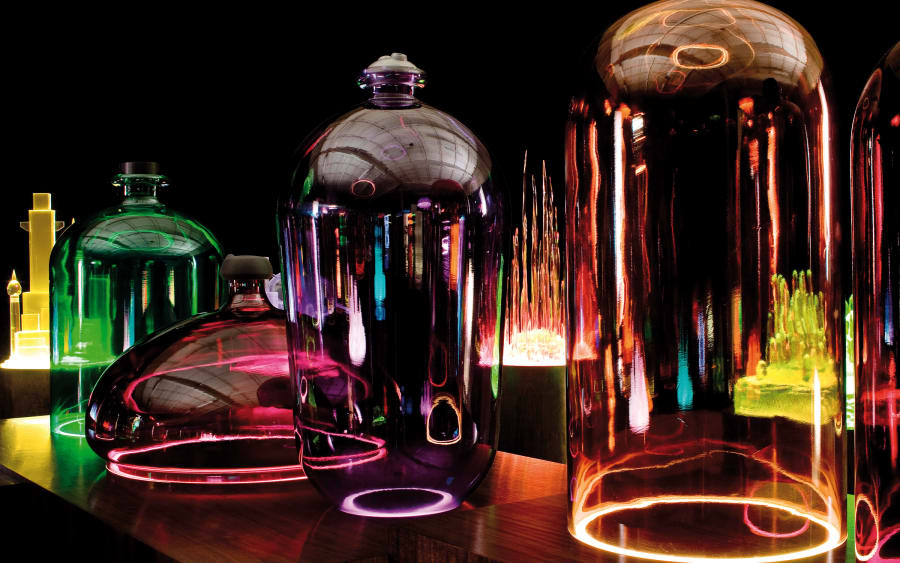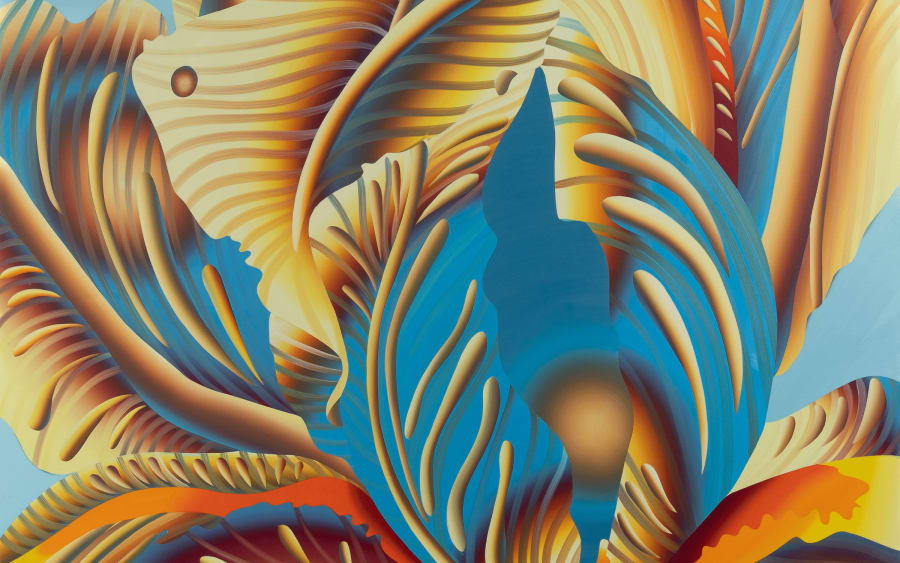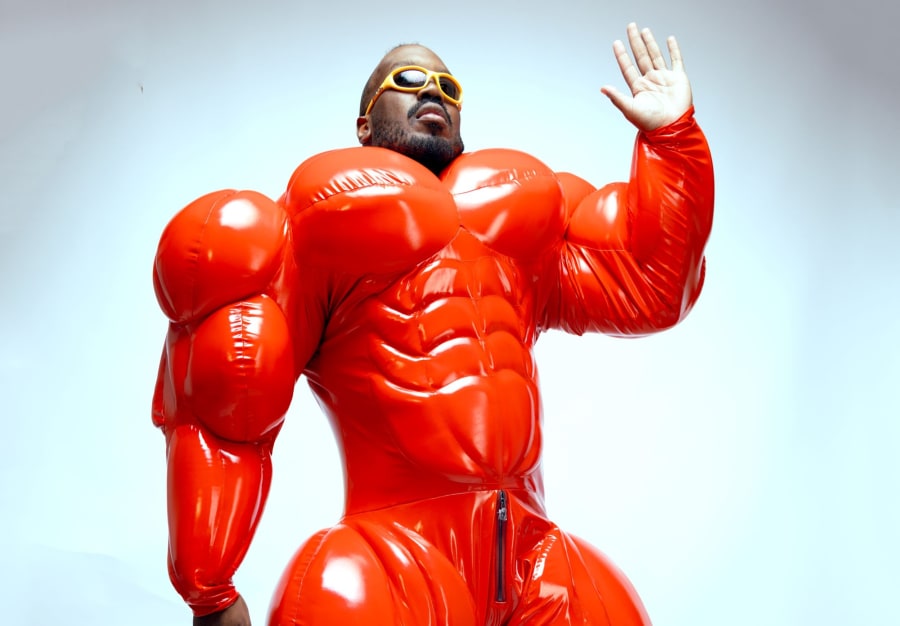A while back we had spoken about The Lady and the Unicorn tapestries at the Musée Cluny in Paris, but since our rendezvous took place in London instead, Caroline Achaintre suggested we view another tapestry together. Less renowned, more surprising, it is preserved behind glass at Young V&A in East London’s Bethnal Green – an anonymous piece, dated 1450-1500, originating from Switzerland. The elegant iron hall where we stand was constructed in 1872, and in 1974 it became the V&A Museum of Childhood; more recently still, after various waves of modernization over the last 20 years, it is now Young V&A. It is an extraordinary playground for an artist who delights in playfulness.
The tapestry we are looking at is as mysterious as it is whimsical. Two men and a woman covered in hair share space with two chimeras. The curation of the object is equally startling: In the same display case, a Paddington teddy bear sits alongside a peculiar rabbit emerging from a papier-mâché egg. ‘I’ve always loved niche museums with unusual collections. This is a place that stimulates the imagination,’ explains Achaintre, who arrived by bicycle from her nearby studio in Hackney. She visited frequently when her daughter was young and was struck by this work depicting humans and beasts in the wild, rendered with sophisticated techniques. With one small caveat: She remembered it to be larger.
In her work, Achaintre practices tufting, a technique that involves poking wool through canvas. This ancient method finds monumental expression in Gobbler (2025), a mask of monstrous proportions that she will present in Art Basel’s Unlimited sector this June. What fascinates Achaintre about tapestry is that the image exists within the textile, rather than being applied to the surface as with a painting. ‘I began working with wool, because I wanted to use domestic materials; I was interested in the uncanny, in Sigmund Freud. I like to think of textiles in a broader context, extending to the ready-made,’ she says.
In the early part of her career, she turned to sculpture and prehistoric art, while also studying the work of Rosemarie Trockel, Mike Kelley, and Paul McCarthy.. These artists’ works contain an element of humor and wildness that one finds in the tapestry at Young V&A. And as we contemplate it, she notes the depiction of fur and hair, and the scale – elements she can directly connect to her own practice. Achaintre recognizes in the depicted revelry the spirit of one of her countries of origin, Germany. ‘It’s a mocking society that exorcises evil and malevolent spirits. It comes from ancient traditions of wild celebrations held a few days each year, during which opposites are inverted and anything becomes possible.’
Perhaps there is also something of the English spirit in this object – an attention to pattern that would resurface centuries later in the Arts and Crafts movement. While Achaintre never sought to follow in the footsteps of William Morris, the movement’s leader, her practice has nonetheless been nourished by the British context. ‘Having begun working in England, in an art scene that was perhaps more open to art rooted in craft traditions than those in Germany or France, it was less necessary to explain what I was doing,’ she observes. During her studies in Britain, she lived in close contact with the post-punk scene, at a time when the Young British Artists were at their peak. Indeed, could these fur-covered humans be compared to the costumed figures currently on display in the Leigh Bowery exhibition at Tate Modern? ‘There’s a video where the dancer and choreographer Michael Clark combs his mohawk. Having spent my youth in subcultures, such as the new wave and punk scenes, that video reminded me that amongst punks, there were many shy people who wore extravagant clothing for protection, to scare away and simultaneously attract – like peacocks displaying their plumage.. That’s something I keep in mind when creating masks.’
In the tapestry at Young V&A, the representation of the woman is surprising: ‘Her entire body is covered in fur except for her knees and breasts. I wonder why the knees! It doesn’t seem to be a question of seduction, but of untamability.’ The bearded man also resembles a beast, covered in hair, with a club in his hand. ‘This weapon is woven particularly well – it’s reminiscent of certain Anni Albers tapestries.’
The hills in the foreground are almost abstract. A single rabbit seems to be traveling across them, depicted at various stages of its journey, as in a chronological frieze. ‘I very much appreciate these plays with perspective, time, and scale that don’t quite make sense. This ochre foreground contrasts with the black background like pale tree leaves that stand out in the forest. Here the colors have faded; my palette is more iridescent.’
Finally, three large creatures traverse the composition like images in a film strip: With inverted crowns around their necks, they are multifaceted, ambivalent, and complex like Achaintre’s own works and her worldview. They are full of humor: a sheep with a dragon’s head, a blue dragon-donkey with hooves and webbed feet, and her favorite – a dromedary precariously balanced on lion’s paws with an upturned snout, held on a leash. ‘In any work, there is always the coexistence of multiple personas. It’s not about schizophrenia but ambiguities. These wild animals look somewhat foolish, but not particularly dangerous. It seems as though the humans must care for them.’ And the rabbit is rather surprised.
Caroline Achaintre is represented by von Bartha (Basel, Copenhagen) and Art : Concept (Paris). Her work Gobbler (2025) will be presented by von Bartha in collaboration with Art : Concept in the Unlimited sector of Art Basel in Basel 2025. Learn more and get your tickets here.
Anaël Pigeat is an art critic, editor-at-large of The Art Newspaper, journalist for Paris Match, and curator.
All photographs by Joss McKinley for Art Basel.
English translation: Art Basel.
Published on May 22, 2025.


